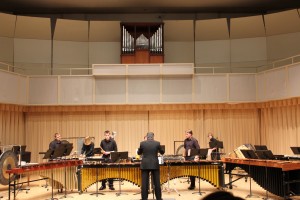
If you have never seen a percussion ensemble, you should. It is certainly a sight, and sound, to behold.
The WCU Percussion Ensemble preformed as a part of the School of Music’s Concert Series on Nov. 19. The concert was held in the Coulter Recital Hall and was a free event.
The recital hall is beautiful with its high ceilings and wood accents. Everyone waits, and quietly murmurs to each other until the percussionists and conductor take the stage. The performers wear black shirts and slacks, and the conductor wears a black suit. The atmosphere seems formal, which adds to the excitement of this type of performance. The audience claps, and then there is silence. The air is heavy with anticipation, from both the audience and the percussionists. One can feel how quiet it is. The mood is very serious and somber until the music begins.
The first piece played took us on a journey through many different sounds and emotions, as did most of the pieces played. It is like your ear is literally taken on an adventure and you are just along for the ride on this musical rollercoaster. It really is exciting.
This peice called, “Teamwork,” started off more classical, then transitioned into what sounded like a jazzy, hip-hop beat near the end. This was a great piece to start off the performance because it was upbeat, and got the audience’s attention because of the unpredictable ending.
This piece was written in 1996 by Lynn Glassock, a Professor at UNC. He teaches Percussion, Introduction to Music Technology and is the Conductor of the UNC Percussion Ensemble. He has won many awards for his compositions, and was also awarded the “Outstanding Service Award” by the Percussive Arts Society in 2004. Glassock has performed with the Dallas Symphony Orchestra, the Fort Worth Symphony, and was the principal percussionist with the Fresno Philharmonic.
This song showcased the many different sounds that can be made with percussion instruments.It was amazing how many sounds can be created by hitting something. There are marimbas (similar to xylophones,) chimes, drums and percussion instruments of every kind. There are different mallets, with different heads, which produce different sounds. There are wood marimbas and drums, as well as metal ones, all varying sizes, each producing a unique sound. There is even a gong!
What is so impressive is the sound the ensemble can create when they all play differently, all at once. When playing all together, the ensemble can create a sound that would not be possible if one person did not play their part. It is inspiring.
They percussionists have tremendous control of their instruments. Sometimes they need to hit the percussion instrument very hard and produce a long ringing sound. Sometimes they must hit it as delicately as they can to produce a tiny sound. The small sound is just as profound as the louder sounds; it is being able to have the control to go from one end of the spectrum to the other without skipping a beat that is remarkable. The timing is also amazing. Everyone is playing something different, and it all comes together perfectly. The xylophonists are playing with four mallets at a time. The xylophonists and drummers sometimes switched mallets multiple times during a song. The result is an invigorating array of pings, dings, and dongs that come together to make an enchanting, intricate song.
There was a short intermission and then the soloist’s preformed. The second soloist, Chris Smith, played the famous Christmas song, Carol of the Bells on marimba.
“Carol of the Bells,” or “Schedryk,” was written by Mykola Leontovich, ukrainian priest, composer, and choral conductor born in 1877. This song was immediately popular, and has been arranged many times by many people to produce different styles and sounds. He taught at Kiev Conservatory and the Lysenko Institute, where he became known as an advocate for the autonomy of the orthodox church his homelands culture. He made his opinions known in his “Liturgy of John Chrysostom,” a piece he composed for an unaccompanied chior and soloist. His fervent nationalism made him a target for Soviets, and he was assassinated in 1921. He is considered a martyr among ukrainians, and his musical legacy is carried on by performers that play this beautiful holiday piece.
Smiths rendition of the piece resonated beautifully in the Recital Hall. Below is a recording of Smith playing “Carol of the Bells.”
The concert was a success, and the audience enjoyed it. If you missed the Percussion Ensemble, there are still two events in the WCU School of Music Series.
~Tues. Dec. 4 7:30 PM, WCU Wind Ensemble, Bardo Arts Center
~Fri. Dec. 7 7:30 PM Western Carolina Civic Orchestra, Coulter Recital Hall


